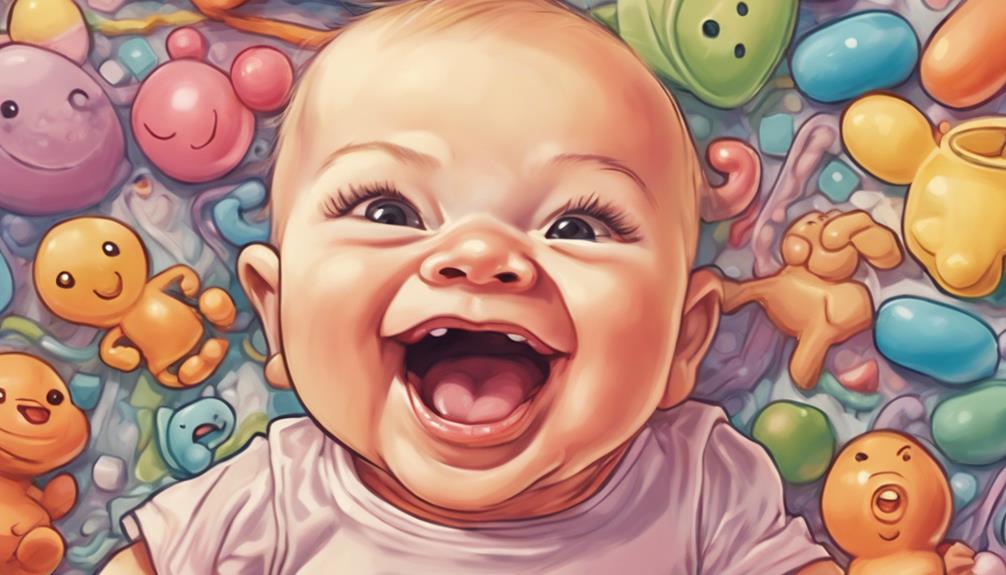Babies teethe as their primary teeth begin to emerge, usually between 6 to 12 months. This natural process helps them chew food properly, which is essential for good nutrition. It also plays a role in speech development and maintains space for permanent teeth. While teething can be uncomfortable, there are several ways you can soothe your baby, like using chilled teething rings or massaging their gums. Understanding this process can ease your worries about discomfort. If you're curious about other aspects of teething and how to support your little one, you'll find plenty of helpful insights ahead.
Key Takeaways
- Babies teethe as their primary teeth, essential for chewing and speech development, begin to emerge between 6 to 12 months of age.
- Teething helps maintain space for permanent teeth and supports overall oral health by preventing decay.
- The process of teething can cause discomfort, prompting parents to seek soothing solutions for their babies.
- Early dental visits are important for monitoring tooth development and establishing good oral hygiene practices.
Teething Timeline
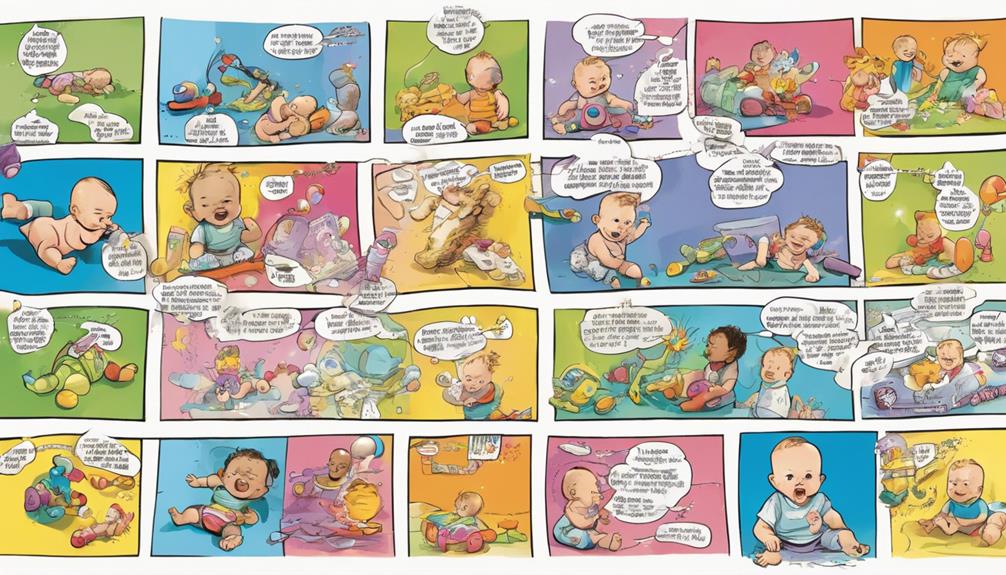
Teething typically starts between 6 to 12 months, and while some babies may not have any teeth by their first birthday, you can expect a specific timeline for when those little pearly whites will begin to emerge. The first teeth to come in are usually the lower central incisors, which typically appear around 6 months of age.
As your baby goes through the teething process, you might notice teething symptoms like drooling, irritability, or difficulty sleeping. These symptoms may start 3-5 days before a tooth breaks through the gum, leading to some discomfort for your little one.
After the first teeth, you'll likely see the upper central incisors erupt between 8 to 12 months, followed by the lateral incisors around 9 to 13 months.
Importance of Baby Teeth
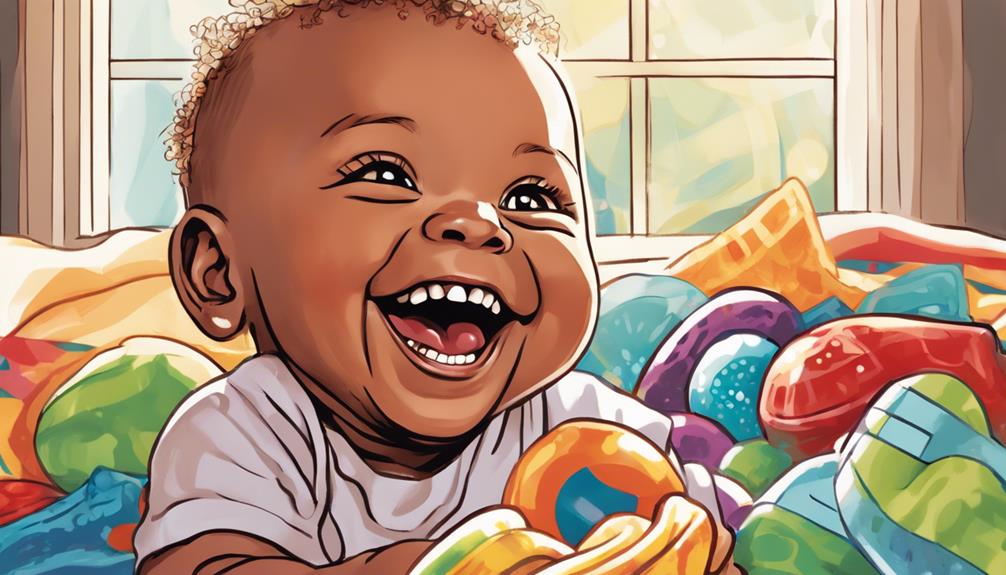
Why are baby teeth so important for your child's development? Baby teeth, or primary teeth, play a significant role in several areas of growth. They help with chewing food, which guarantees your child gets proper nutrition. Additionally, these teeth are essential for speech development, allowing your little one to pronounce words clearly. Furthermore, baby teeth hold the space in the jaw for the permanent teeth to come in properly. If a baby tooth is lost too early, it can lead to spacing issues and misalignment of the permanent teeth. This is why baby teeth delay the eruption of permanent teeth until the right time. Overall, maintaining good oral hygiene and taking care of baby teeth is crucial for your child’s overall health and development.
Here's a quick overview of the importance of baby teeth:
| Importance | Impact on Development | Consequence of Neglect |
|---|---|---|
| Chewing Food | Aids in proper nutrition | Poor nutrition |
| Speech Development | Helps in clear pronunciation | Speech delays |
| Space Maintenance | Holds space for permanent teeth | Misalignment of adult teeth |
| Self-Esteem | Boosts confidence in social settings | Low self-esteem |
| Oral Health | Prevents tooth decay | Risk of cavities and pain |
Taking proper dental care of baby teeth is imperative. Neglecting them can lead to tooth decay, affecting not just oral health but also the eruption of permanent teeth. By prioritizing your child's baby teeth, you're setting a foundation for a healthy smile and confident future.
Soothing Teething Discomfort
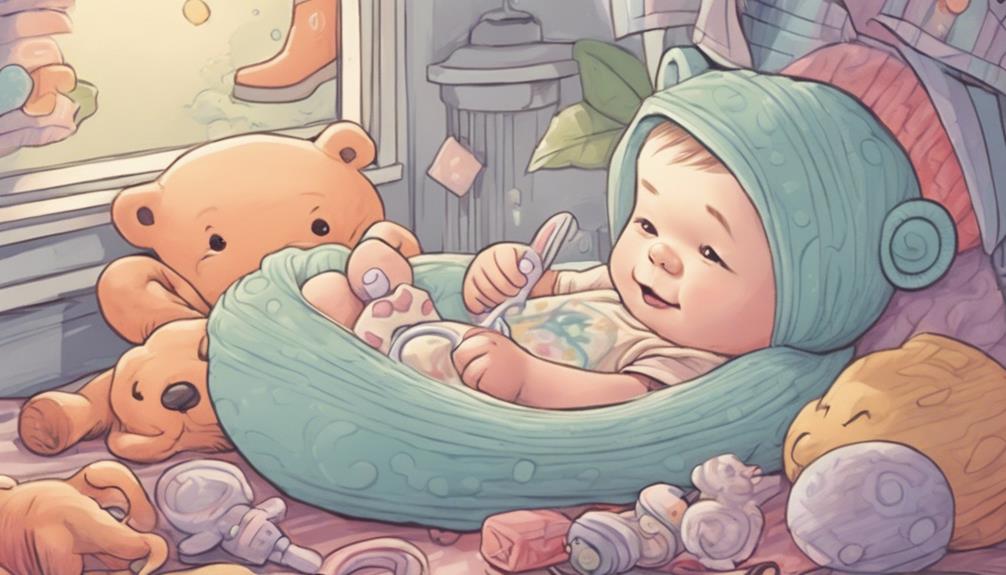
When your baby starts teething, finding effective ways to soothe their discomfort is essential.
You can try various safe teething products and techniques to help ease their pain.
Let's explore some of the best methods to keep your little one comfortable during this challenging time.
Effective Soothing Techniques
Gently massaging your baby's gums with a clean finger often provides much-needed relief from teething discomfort. This simple action offers counter-pressure against swollen gums, helping to soothe your little one.
In addition to finger massages, consider these effective soothing techniques:
- Chilled Teething Rings: Refrigerate a teething ring for a short time. The cold helps numb sore gums and reduce inflammation.
- Frozen Washcloths: Soak a washcloth in water, freeze it for a bit, and let your baby chew on it. The cold texture can provide instant relief.
- Teething Biscuits: Offer age-appropriate teething biscuits that your baby can gnaw on. Always monitor them to prevent choking, ensuring they're soft enough for safe consumption.
While teething pain can cause slight temperature elevation, a true fever (over 100.4°F) may signal an illness, so consult your pediatrician if that happens.
Safe Teething Products
Finding safe teething products is essential to soothing your baby's discomfort while guaranteeing their safety during this challenging time.
Look for teething rings made of silicone or rubber, as these materials are easy to clean and free from harmful substances, providing a safe option for your little one to chew on. Chilled teething rings or frozen washcloths can also help soothe gums and offer temporary relief from teething discomfort.
Teething toys with varying textures can stimulate sore gums without presenting a choking hazard, allowing your baby to find comfort as they teeth. It's vital to avoid teething products that contain liquid, as they can pose a choking risk if broken. Additionally, steer clear of teething gels with benzocaine for infants under 2 years due to safety concerns.
Always supervise babies when using teething products to guarantee their safety. Keeping a close eye on them can prevent potential accidents related to choking or injury.
Common Misconceptions
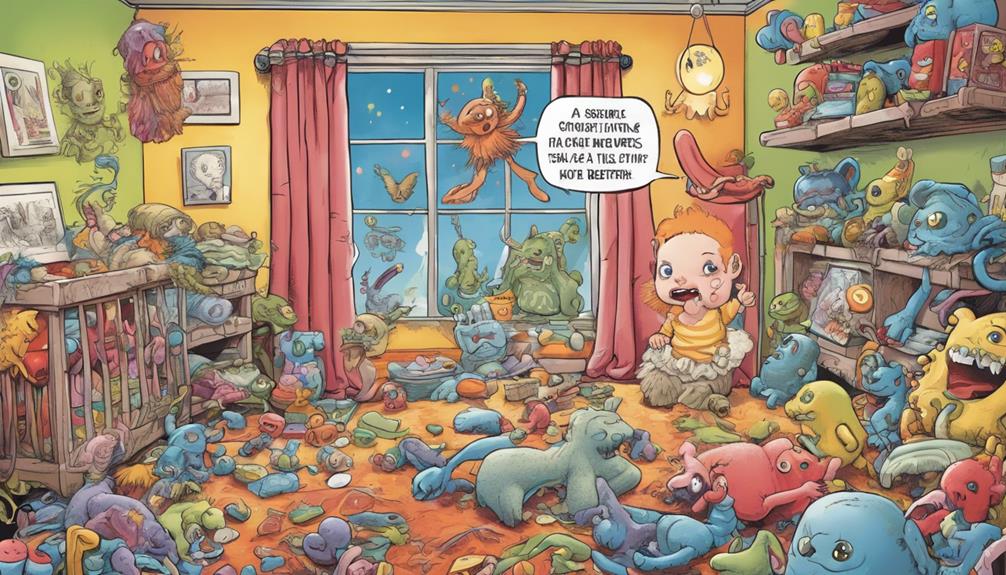
Teething is often misunderstood, leading parents to believe in several myths that can cause unnecessary worry and confusion. Here are some common misconceptions about teething that you should know:
- Teething and Fever: Many think teething causes high fevers, but it typically only leads to a mild temperature below 100.4°F. A true fever indicates an illness, not just teething.
- Pain Tolerance: It's a widespread belief that all babies suffer severe pain during teething. In reality, pain tolerance varies among infants, and some may experience only minimal distress.
- Gastrointestinal Symptoms: Some parents assume teething can cause diarrhea. However, research shows that gastrointestinal symptoms aren't linked to teething and may signal other health issues.
Additionally, many believe that teething gels containing benzocaine are safe for infants, but the FDA warns against their use due to serious side effects.
It's crucial to separate fact from fiction to guarantee your baby's comfort and safety while teething. Understanding these misconceptions can help you better support your little one during this natural process.
Oral Hygiene Practices

Establishing good oral hygiene practices early on is crucial for your baby's dental health and sets the foundation for a lifetime of healthy habits.
Start by cleaning your baby's gums daily with a wet washcloth or gauze, even before their baby teeth appear. This routine helps familiarize them with oral hygiene.
Once those first teeth emerge, brush your child's teeth twice daily using fluoride toothpaste—a smear for those under age 3 and a pea-sized amount for kids over 3.
Avoid putting your baby to bed with a bottle, as this can lead to dental problems like 'baby bottle syndrome,' which results in decay.
As your child grows, monitor and assist them with brushing until they're around 7 or 8 years old to verify they're using the correct techniques. Teach them to spit out excess toothpaste when they're able, as swallowing too much fluoride toothpaste can lead to dental fluorosis.
Regular dental appointments with a pediatric dentist will help maintain your child's oral hygiene and catch any potential issues early.
First Dental Visit
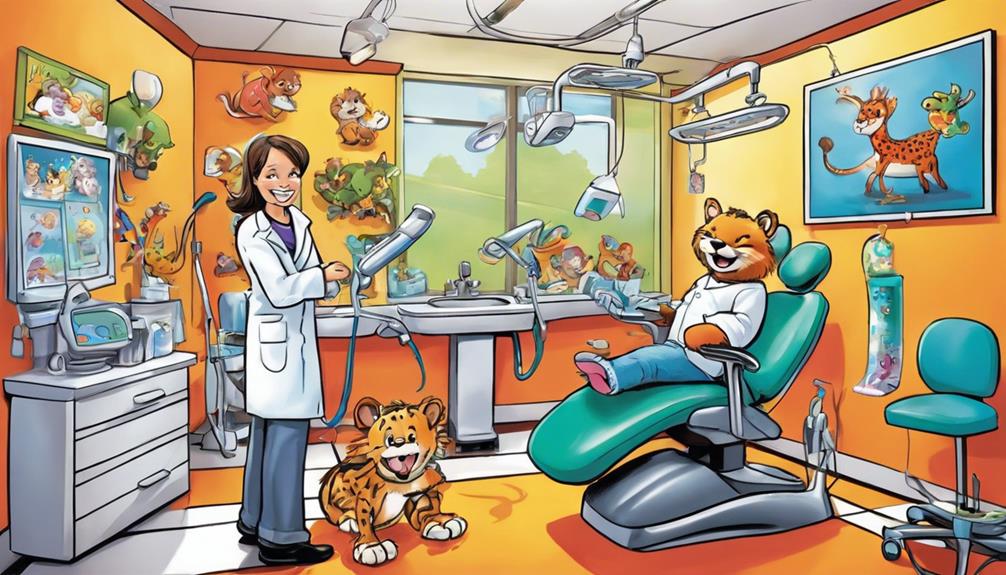
It's essential to schedule your baby's first dental visit after their first tooth appears or by their first birthday.
Choosing the right pediatric dentist can make this experience comfortable and informative for both you and your child.
During the appointment, you'll learn what to expect as your little one's teeth develop and how to maintain their oral health.
Timing for First Appointment
Scheduling your baby's first dental appointment after their first tooth erupts or by their first birthday is essential for fostering good oral health habits. Early visits help establish a 'dental home,' ensuring ongoing care and education tailored to your child's needs. The American Academy of Pediatric Dentistry recommends this timing to set the foundation for a lifetime of healthy smiles.
Here are three key reasons to prioritize this first dental visit:
- Monitoring Development: A pediatric dentist can track your baby's dental development and address any concerns early on.
- Guidance on Oral Hygiene: You'll receive personalized advice on maintaining your child's oral hygiene, setting them up for success as they grow.
- Preventing Dental Decay: Regular check-ups, starting with that first appointment, can greatly reduce the risk of dental decay and cavities.
Choosing a Pediatric Dentist
Choosing the right pediatric dentist can greatly impact your child's comfort and confidence during their first dental visit. It's vital to find a dentist who specializes in the unique dental needs of children, as they provide age-appropriate care tailored to your little one's developing deciduous teeth. The American Academy of Pediatric Dentistry recommends scheduling this visit after the first tooth erupts or by your child's first birthday.
During the first dental visit, the pediatric dentist won't only check your child's mouth but also offer valuable advice on teething, oral hygiene, and dietary choices that support dental health. This early intervention is important to prevent tooth decay, one of the most common childhood diseases. Regular check-ups with a pediatric dentist can help establish a dental home, allowing you to monitor your child's oral health effectively.
Creating a positive dental experience during these initial visits can alleviate any fear your child may have about dental care, promoting a lifetime of good dental habits. By choosing a pediatric dentist who prioritizes your child's needs, you're setting the stage for a healthy smile and a confident attitude towards oral hygiene.
What to Expect
During your child's first dental visit, expect a friendly environment where the dentist will gently examine their mouth and discuss important aspects of oral health. This visit is vital for establishing early dental health and guaranteeing that your child's baby teeth and gums are developing properly.
Here's what you can anticipate:
- Examination: The pediatric dentist will check your child's mouth for any issues, such as cavities or misalignment, and guarantee their baby teeth are coming in correctly.
- Teething Guidance: You'll receive advice on teething, including the use of teething tablets and what to expect as more teeth come in.
- Oral Hygiene Tips: The dentist will provide tailored recommendations for maintaining your child's oral hygiene, emphasizing the importance of brushing and caring for young teeth and gums.
Establishing a dental home by the age of one helps set the groundwork for regular check-ups and preventive care.
It's a wonderful opportunity to address any concerns and learn how to keep your child's smile healthy as they grow!
Frequently Asked Questions
Why Do Babies Start Teething?
Babies start teething as their primary teeth push through the gums, usually between 6 to 12 months. This natural process can cause discomfort, increased drooling, and fussiness, signaling growth and development in their mouths.
What Is the Purpose of Teething?
Did you know that nearly 80% of children experience teething discomfort? Teething's purpose is essential: it paves the way for healthy chewing, supports speech development, and guarantees proper spacing for future permanent teeth.
Why Does Teething Hurt for Babies?
Teething hurts for babies because their teeth push through sensitive gums, causing inflammation and discomfort. You might notice your little one feeling fussy, seeking relief by chewing on hard objects to ease the pain.
Why Do Babies Need to Bite When Teething?
When your baby bites, they're seeking relief, distracting themselves from discomfort, and exploring their world. Chewing on objects soothes swollen gums, promotes healing, and helps develop essential motor skills as they navigate this challenging phase.
Can Teething Cause Headaches in Babies?
Teething can cause discomfort for babies, but it doesn’t typically lead to headaches. However, a child’s dental health and headaches could be related if there are other issues present, such as tooth decay or misalignment. It’s important to monitor your child’s dental health to prevent any potential headaches.
Is Delayed Teething a Cause for Concern in Babies?
Delayed teething in babies is not always a cause for concern. There are various reasons why baby teeth delayed, such as genetics, premature birth, or nutritional deficiencies. It’s important for parents to monitor their baby’s development and consult a pediatric dentist if they have concerns about delayed teething.
How Does Teething in Babies Relate to the Importance of Brushing Teeth for Kids?
Teething in babies is a natural process that begins around six months old. It is crucial to start teaching the importance of bedtime brushing as soon as the first tooth appears. Developing this habit early on will set the foundation for good oral hygiene and help prevent dental issues in the future.
Conclusion
As your little one's first teeth emerge like tiny pearls breaking through the surface, you'll witness a beautiful transformation.
Embrace the joy of this milestone, knowing those baby teeth are essential for future smiles and healthy development.
While teething can be challenging, remember the soothing methods to ease discomfort.
By nurturing their oral hygiene from the start and scheduling that first dental visit, you're setting the stage for a lifetime of bright, confident grins.
